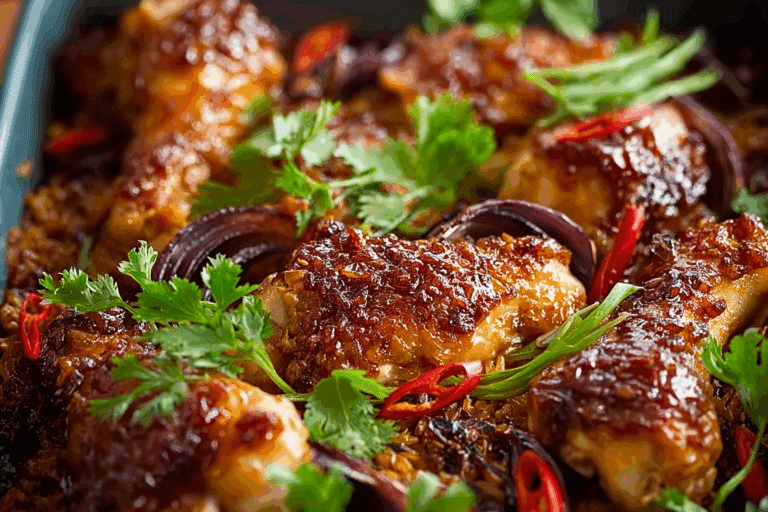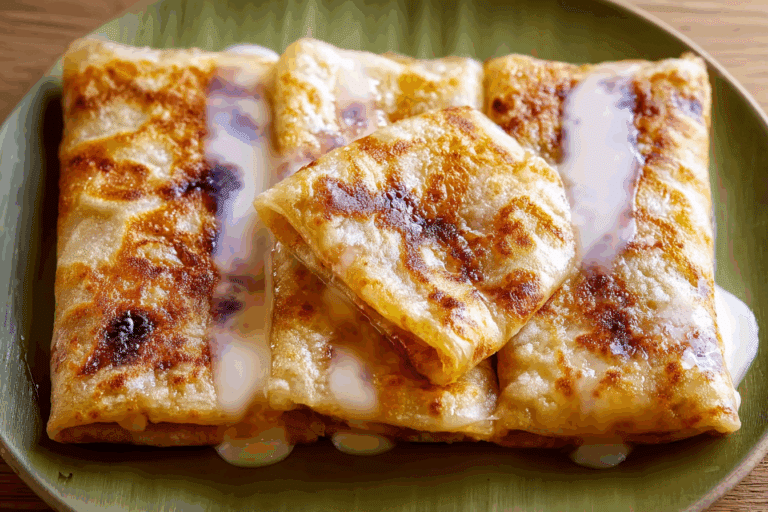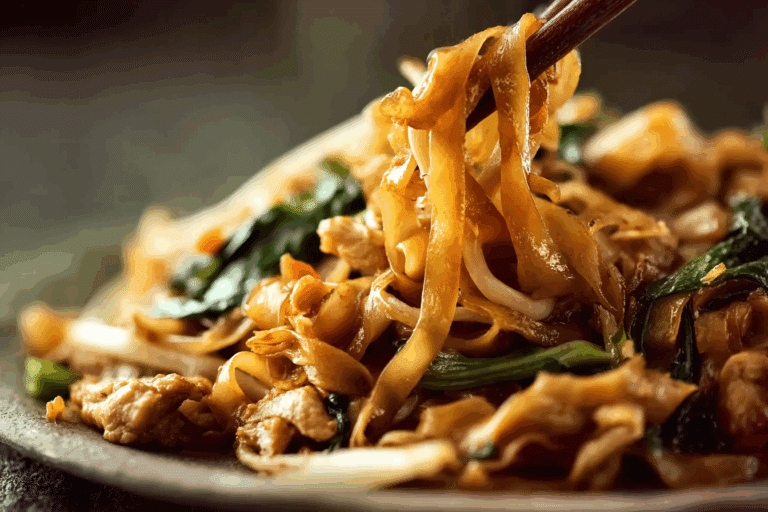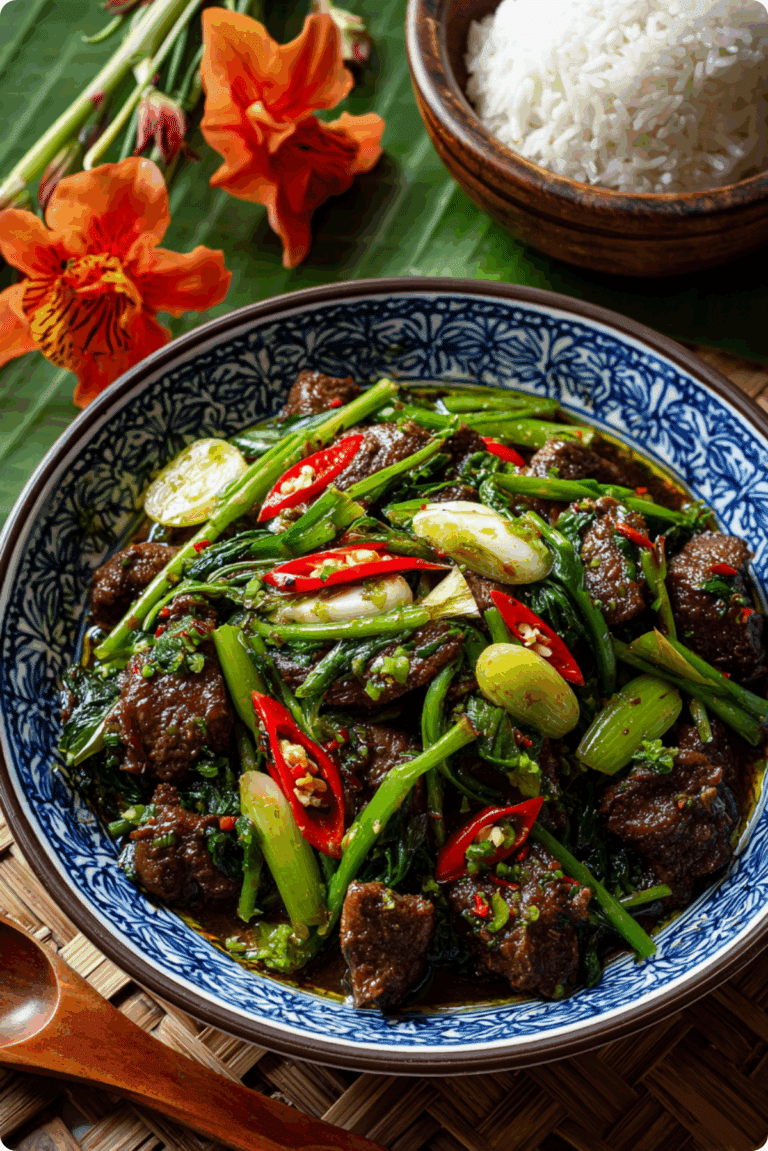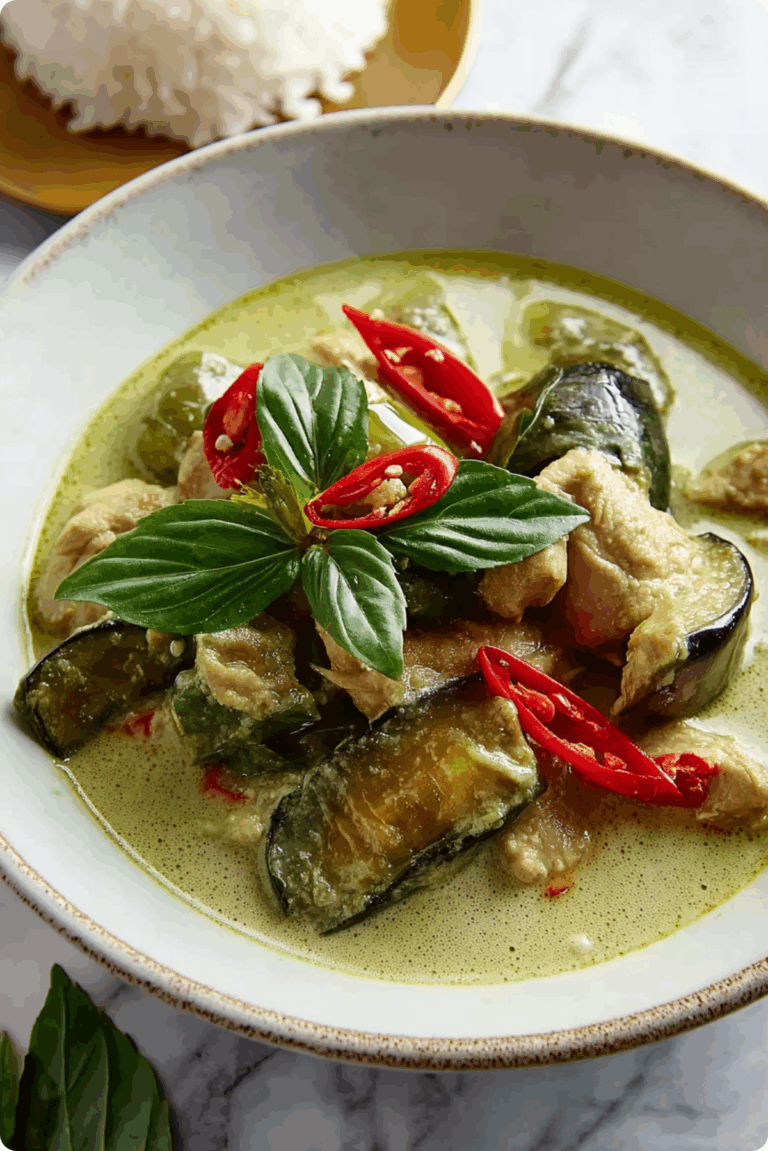Suki Dry Noodles Fast, Fresh and Full of Flavor
Suki Dry Noodles, one of Thailand’s most comforting and flavorful dishes, is more than just a quick meal. It is a story on a plate, filled with warmth, family memories, and the familiar aroma of sizzling sesame oil in a hot wok. When I first discovered this recipe for my About page, I never imagined how deeply it would connect me to Thai street food culture.
I remember walking through the busy markets of Bangkok, where vendors shouted orders and the air smelled like spice, soy, and grilled meat. There, I had my first bite of Suki Dry Noodles, a dish that tasted like home even though I was miles away from mine.
This blog was born from that exact feeling the desire to share recipes that bring people together. Every recipe I share on this site carries a piece of that journey, including this delicious Suki Dry Noodles recipe. It combines silky bean thread noodles, crisp vegetables, tender beef, and the rich, spicy flavor of sukiyaki sauce. The magic happens when all the ingredients meet in the wok, sizzling in sesame oil, binding together into something simple yet unforgettable.
If you love the balance of spicy, savory, and slightly sweet flavors found in dishes like Thai suki noodle soup or old Thai style noodles, then you are going to adore this version. Suki Dry Noodles are quick to make, easy to customize, and bursting with texture. In this post, you will learn how to make the most authentic version of this dish right at home, discover variations like Suki hang and suki nam recipe, and even learn how to prepare the signature Suki sauce Thai style. Get ready to dive into a world of flavor that will have your kitchen smelling like the streets of Thailand in no time.
Table of Contents
Table of Contents
Ingredients
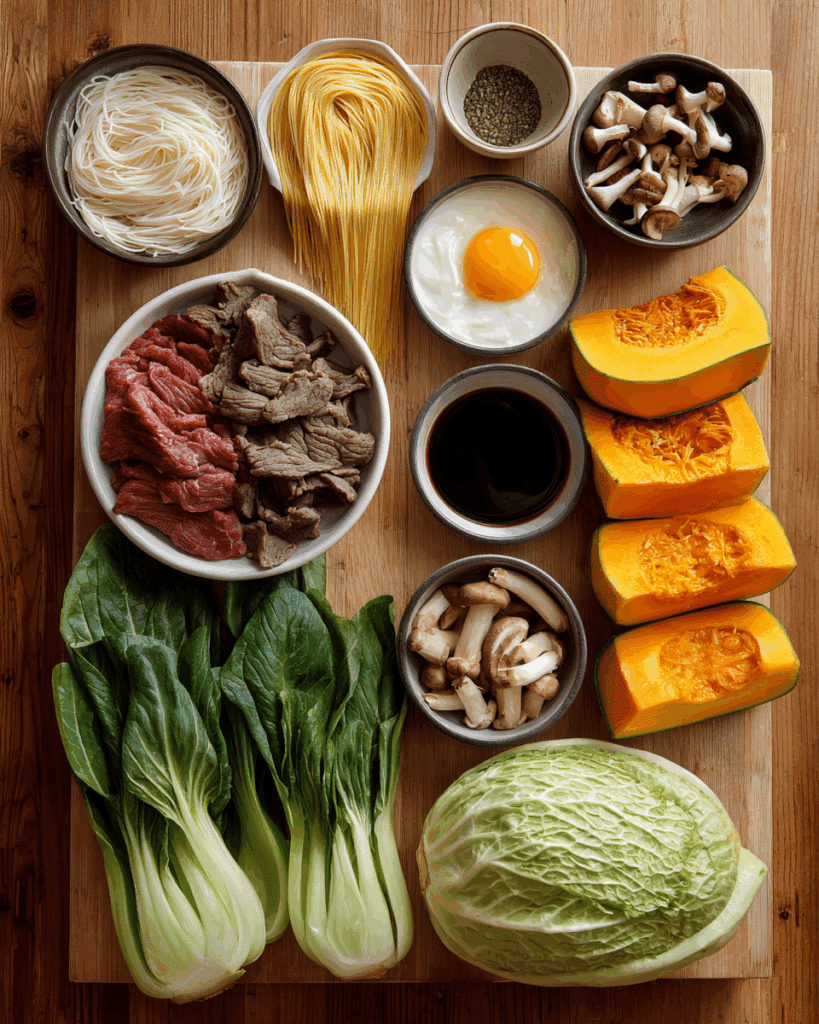
The secret behind perfect Suki Dry Noodles starts with fresh, quality ingredients that complement each other in both flavor and texture. Let’s look at everything you will need to make this dish come alive.
- 1 Tablespoon sesame oil
- ¼ cup thinly sliced beef
- 1 egg
- 2 ounces bean thread noodles (also called glass noodles or cellophane noodles)
- 2 to 4 Tablespoons sukiyaki sauce, depending on your preferred heat level
- ¼ cup kabocha squash, cut into small pieces
- ¼ cup mushrooms, sliced thin
- ¼ cup bok choy, chopped
- ¼ cup napa cabbage, chopped
These ingredients create the foundation of your Suki Dry Noodles. The sesame oil gives a nutty aroma that sets the tone for the dish. The beef adds protein and a savory bite, while the egg creates richness that ties the noodles together. The vegetables are essential, adding crunch and sweetness to balance the sauce.
If you want to explore more noodle recipes like these, check out [Internal Link: Thai Pad See Ew Recipe] or [Internal Link: Stir Fried Thai Glass Noodles]. Both are close relatives of Suki Dry Noodles and highlight how diverse Thai noodle dishes can be.
A quick note on customization: you can easily swap the beef for chicken, pork, tofu, or even shrimp. Vegetarians often enjoy this dish by skipping the meat and doubling the vegetables. The noodles, made from mung bean starch, are gluten-free, which makes this a great option for those avoiding wheat. You can also adjust the spice level by changing the amount of sukiyaki sauce you use. If you like your Suki Dry Noodles mild, start with 2 tablespoons. For a stronger, fiery punch, go with 4 tablespoons or even a bit more.
It is also worth mentioning that the ingredients can be prepped in advance. You can slice your vegetables, soak your noodles, and keep everything in separate containers in the fridge. When you are ready to cook, the process will take less than 15 minutes from start to finish. This makes Suki Dry Noodles a perfect weeknight meal that feels special without taking too much time.
Step-by-Step Instructions

Cooking Suki Dry Noodles is not only fun but also incredibly satisfying. The sizzling sound of sesame oil, the rich aroma of sukiyaki sauce, and the vibrant colors of the vegetables all come together in perfect harmony. Here is how you can make this dish at home, just like the street vendors in Thailand do.
- Soak the noodles.
Start by soaking the bean thread noodles in warm water for several minutes. This softens them and prepares them for stir-frying. While they soak, wash and chop your vegetables so everything is ready to go. The noodles should be flexible but not mushy. - Heat the sesame oil.
In a large wok or skillet, heat one tablespoon of sesame oil over medium-high heat. Once it is hot and shimmering, add the thinly sliced beef. Stir-fry the meat until it is browned and cooked through. The sesame oil will fill your kitchen with an irresistible aroma. - Add the egg.
Push the cooked beef to one side of the wok. Crack an egg on the other side and scramble it. Once the egg is cooked, combine it with the beef. This step builds the rich base flavor that makes Suki Dry Noodles so delicious. - Cook the noodles.
Drain the softened noodles and add them to the wok. Pour in a little water to rehydrate them further and prevent sticking. Continue stirring as the noodles soften and begin to soak up the oil and meat juices. - Add the sauce.
Pour in your sukiyaki sauce and toss everything until evenly coated. The sauce should cling to the noodles and coat each strand. You can taste at this stage to adjust the heat level by adding more sauce if needed. - Add the vegetables.
Push the noodles to one side and add your kabocha squash and mushrooms. Add a splash of water, about a tablespoon or two at a time, to help steam the vegetables. When they are nearly cooked, toss in the bok choy and napa cabbage. Stir until everything is just wilted but still vibrant and fresh. - Final toss and serve.
Give everything a final mix to combine the flavors. Serve immediately with a small bowl of extra suki sauce Thai style on the side. The contrast between the dry noodles and the dipping sauce is what makes this dish so addictive.
For more inspiration on authentic Thai recipes, you can explore sites like Rachel Cooks Thai and Hungry in Thailand, both of which offer deep dives into dishes similar to Suki Dry Noodles and their regional variations.
Cooking this dish might take a few tries to perfect, but once you do, it becomes second nature. Each time you prepare Suki Dry Noodles, you can experiment with ingredients, sauces, and textures. That is the beauty of Thai cooking it is flexible, colorful, and deeply personal. Whether you are craving Suki hang, dry suki, or suki nam recipe, this dish will satisfy every noodle lover’s heart.
Tips & Tricks
Making Suki Dry Noodles might seem simple, but a few small details can turn your dish from good to absolutely amazing. The beauty of Suki Dry Noodles lies in balance. Every bite should feel light yet satisfying, with noodles that soak up just enough sauce and vegetables that stay bright and crisp. Below are my favorite tips that will help you make the best version possible, even if it is your first time.
The first and most important thing to remember when cooking Suki Dry Noodles is not to over-soak the noodles. Bean thread noodles, or glass noodles, can become too soft if left in water too long. They should be flexible but slightly firm before hitting the wok. This helps them absorb the sauce perfectly without turning mushy. If you want your Suki Dry Noodles to have that authentic street food texture, soak them for about five to seven minutes and then let them finish cooking in the wok.
Another helpful trick is to prepare all your ingredients before turning on the stove. Thai cooking moves quickly, and once you start stir-frying, there is no time to chop or measure. Have your vegetables, sauce, meat, and egg ready to go. This way, the Suki Dry Noodles will come together smoothly, and you will avoid burning the sauce or overcooking the vegetables.
The heat level of your pan also makes a big difference. For traditional Suki Dry Noodles, medium-high heat works best. The sesame oil should sizzle gently when you add the beef. If it is smoking too much, lower the heat a little. If it is too quiet, raise the temperature slightly. Finding that sweet spot helps lock in the flavors and gives your noodles a slightly smoky aroma that reminds you of real Thai street stalls.
Do not be afraid to taste as you go. Suki Dry Noodles are meant to be adjusted to your liking. Add a little more sukiyaki sauce if you want extra spice or mix in a spoon of sugar if you prefer a touch of sweetness. If you find the noodles sticking together, splash a little water or broth. It helps loosen them and keeps the dish glossy.
You can also play around with toppings. Some people love to add fried garlic or crushed peanuts for crunch. Others sprinkle a bit of lime juice right before serving to give a refreshing tang that balances the spicy suki sauce Thai flavor. You can even drizzle a few drops of chili oil on top for that fiery kick. These small touches make your Suki Dry Noodles taste unique and personal.
If you are storing leftovers, reheat them in a pan instead of the microwave. Add a little water and sesame oil to bring back the moisture. Stir gently over medium heat until warm. The noodles will taste almost as good as freshly made. The next day, they even absorb more flavor, making your Suki Dry Noodles taste deeper and richer.
Finally, remember that Suki Dry Noodles are meant to be enjoyed with friends or family. Serve them straight from the wok while they are still steaming hot. The combination of texture, aroma, and flavor will make everyone at the table smile. Cooking this dish should feel joyful and a little bit messy, just like all the best food memories do.
Variations
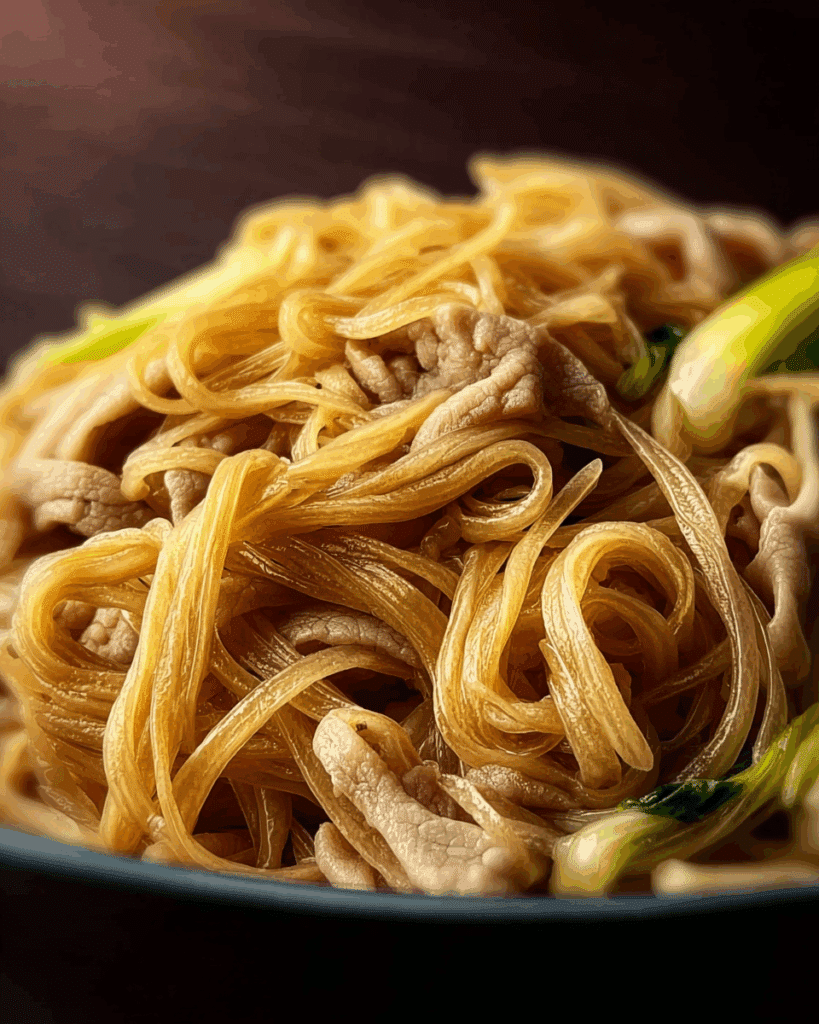
One of the best things about Suki Dry Noodles is how easy it is to adapt them to your taste. The base recipe is simple, and you can change it up with different proteins, sauces, and vegetables. Every region in Thailand has its own version of Suki Dry Noodles, and home cooks often put their personal spin on it. Let’s explore a few popular variations you can try right in your kitchen.
1. Chicken Suki Dry Noodles
If you prefer a lighter version, try making Suki Dry Noodles with thin slices of chicken breast. The chicken absorbs the sukiyaki sauce beautifully and keeps the dish juicy. You can also use chicken thighs for extra flavor. Add a few drops of fish sauce to the mix to give it a slightly savory depth that pairs perfectly with the glass noodles.
2. Seafood Suki Dry Noodles
This variation is a favorite among seafood lovers. You can add shrimp, squid, or even scallops to your Suki Dry Noodles. The natural sweetness of the seafood balances the heat from the suki sauce Thai blend. A handful of fresh basil leaves added at the end gives a nice herbal aroma that elevates the entire dish. If you enjoy spicy seafood dishes, this version will quickly become your go-to.
3. Vegetarian Suki Dry Noodles
If you are avoiding meat, Suki Dry Noodles can easily become a vegetarian-friendly dish. Replace the beef with tofu or tempeh and use vegetable broth instead of water when rehydrating the noodles. Pile in more mushrooms, bok choy, and napa cabbage. The vegetables soak up the sukiyaki sauce so well that you will not miss the meat at all. A drizzle of toasted sesame oil before serving adds a deep nutty note that ties everything together.
4. Spicy Suki Hang Style
Suki hang is another popular variation, where the dish is cooked dry with more concentrated sauce and no broth. The result is fiery, smoky, and packed with flavor. To make this, reduce the water slightly when rehydrating the noodles and increase the sukiyaki sauce. Stir-fry everything until the noodles caramelize a bit at the bottom. The slightly charred edges are what make this style so addictive.
5. Suki Nam Recipe
If you love soups, you can easily transform your Suki Dry Noodles into a suki nam recipe. Simply add broth after mixing the noodles with the sauce. The result is a comforting, warm noodle soup that still carries the signature suki flavor. It’s perfect for colder days or when you crave something cozy.
Suki Dry Noodles are also great for meal prep. You can make a large batch, divide it into portions, and store them in the fridge for quick lunches. Each time you reheat a portion, add a splash of water and maybe a bit more sukiyaki sauce to refresh the flavor. It will feel like a brand-new dish every time.
Whether you choose chicken, beef, tofu, or seafood, each version tells a different story. That is what makes Suki Dry Noodles so special. They adapt to your cravings, your mood, and even the season. Try mixing up the vegetables based on what is in season like carrots, bell peppers, or snow peas. Once you start experimenting, you will realize there is no single way to enjoy this dish, only your way.
Nutrition & Health Benefits
At first glance, Suki Dry Noodles might look like an indulgent comfort meal, but it actually offers a balanced mix of nutrients that make it both satisfying and wholesome. Each ingredient brings its own set of health benefits, and together they create a dish that nourishes your body as much as it delights your taste buds.
Let’s start with the noodles. The bean thread noodles used in Suki Dry Noodles are made from mung beans, which are naturally gluten-free and low in fat. They provide a good source of complex carbohydrates, giving you energy without feeling heavy. Because they are light, they also absorb flavor well, allowing you to enjoy the taste without adding unnecessary calories. A serving of Suki Dry Noodles typically has around 350 to 400 calories, depending on how much oil and sauce you use.
The vegetables in Suki Dry Noodles add both fiber and vitamins. Bok choy and napa cabbage are rich in vitamin C and vitamin K, which support your immune system and bone health. Mushrooms bring in antioxidants and a touch of umami flavor. Kabocha squash adds beta-carotene, which your body turns into vitamin A for healthy skin and vision. Together, these vegetables make Suki Dry Noodles not just tasty but also nourishing.
The protein from beef or other meat choices provides essential amino acids your body needs for muscle repair. If you choose tofu or seafood, you still get a healthy dose of protein with less fat. The egg adds additional nutrients like vitamin D, B12, and choline, all of which are great for energy and brain health.
Sesame oil, used in small amounts, gives Suki Dry Noodles their signature aroma while offering healthy fats. These fats help your body absorb vitamins from the vegetables more effectively. Just remember not to overuse it, since a little goes a long way.
The sukiyaki sauce, while flavorful, can be high in sodium, so if you are watching your salt intake, choose a low-sodium version or make your own at home using light soy sauce, garlic, chili, and vinegar. This keeps the dish balanced without sacrificing that signature punchy flavor.
In general, Suki Dry Noodles are a great choice for people who want a meal that feels indulgent but still supports a healthy lifestyle. It has a good balance of protein, carbs, and vegetables, and it is easy to customize for different dietary needs. You can make it high-protein, low-carb, vegetarian, or even vegan with just a few simple swaps.
What makes Suki Dry Noodles truly beneficial is that it encourages mindful eating. When you cook it at home, you control every ingredient, every spice, and every portion. That kind of connection with your food makes each meal more meaningful. Plus, it proves that healthy eating does not have to be boring it can be full of color, aroma, and flavor, just like a bowl of steaming Suki Dry Noodles.
Make-Ahead, Storage and Freezing
Suki Dry Noodles reward a little planning, and that is great news for busy cooks. When you want dinner to feel easy and still taste vibrant, Suki Dry Noodles deliver. The trick is to think in small steps, which keeps texture and flavor bright. Here is how I prep Suki Dry Noodles in advance without losing that bouncy bite we all love.
Start by soaking the bean thread noodles and then draining them well. Toss the noodles with a tiny splash of sesame oil so they do not clump, then chill them in a sealed container. When I plan Suki Dry Noodles for tomorrow’s lunch, I also chop the bok choy, napa cabbage, mushrooms, and kabocha. I keep each vegetable in its own small container. This makes Suki Dry Noodles feel like a quick stir fry bar, everything ready to toss into the wok. I slice the beef and crack an egg into a jar for easy scrambling later. With these simple steps, Suki Dry Noodles go from fridge to table in under ten minutes.
If you are packing Suki Dry Noodles for work, cook the noodles and sauce together first, then cool them completely before sealing. Keep the vegetables slightly underdone, because Suki Dry Noodles will continue to soften when reheated. I portion the Suki Dry Noodles into microwave safe bowls, then top each one with a spoon of extra sauce in a separate cup. When lunchtime comes, Suki Dry Noodles regain shine and heat with just a minute or two in the microwave, and a quick toss brings everything back to life.
Freezing Suki Dry Noodles takes a bit of care. Bean thread noodles can get fragile if frozen carelessly, yet it is still possible. I scoop cooled Suki Dry Noodles into freezer bags, flatten them for fast thawing, and press out extra air. Label the date so you remember to enjoy your Suki Dry Noodles within one month. For best results, thaw Suki Dry Noodles overnight in the fridge, then warm them in a skillet with a splash of water. The noodles loosen, the sauce wakes up, and Suki Dry Noodles taste nearly fresh again.
If you want to freeze components instead, that works beautifully. Blanch the vegetables for a minute, shock them in cold water, drain well, and freeze. Slice the beef and freeze it flat in a thin layer so it defrosts quickly. With those pieces ready, Suki Dry Noodles come together fast on a busy night. I love this approach because it keeps the final texture lively. When everything hits the hot pan, Suki Dry Noodles stay springy, the vegetables stay crisp, and dinner feels bright.
For short term storage, Suki Dry Noodles last three to four days in the refrigerator when sealed tight. I keep a small jar of sukiyaki sauce on the side, since a drizzle before serving wakes up flavor. If the noodles clump after chilling, I loosen Suki Dry Noodles with a tablespoon of water or broth in a hot pan. Stir patiently and you will see Suki Dry Noodles relax again, glossy and ready.
Meal prepping for a crowd can be fun too. Cook a large batch of Suki Dry Noodles, lay them on a sheet pan to cool quickly, then portion into containers. Add a little extra egg or tofu for protein if you like. The next day, Suki Dry Noodles taste even deeper because the sauce has had time to cuddle into every strand. It is the kind of make ahead plan that makes your week flow better, and Suki Dry Noodles never feel like leftovers, they feel like a gift you gave yourself.
The last tip is about timing. If you know you will reheat, slightly undercook everything at first. That way, Suki Dry Noodles finish cooking during reheating and stay tender. A squeeze of lime or a pinch of sugar can balance flavor after a day in the fridge. With a few mindful choices, Suki Dry Noodles keep their spirit, from Sunday prep to Thursday lunch, and you still get that just cooked joy.
Common Mistakes to Avoid

Even simple recipes have a few places where things can go sideways, and Suki Dry Noodles are no different. Knowing these common mistakes makes your cooking smoother and your meal more delicious. Here are the pitfalls I see most often, along with easy fixes that keep Suki Dry Noodles on track.
Over soaking the noodles is the first big one. Bean thread noodles soften quickly, and if they sit too long in water, Suki Dry Noodles turn limp and sticky. Soak until flexible, not floppy. If you accidentally over soak, drain them well, pat them dry, and reduce added water during cooking. This helps Suki Dry Noodles hold shape.
Crowding the pan is another issue. When the wok is too full, ingredients steam instead of sear. Suki Dry Noodles thrive in hot, quick contact with the pan. If your pan is small, cook in batches. A brief sear on the beef, a quick scramble on the egg, and then the noodles get their moment. Layering heat like this keeps Suki Dry Noodles bouncy and flavorful.
Adding all the vegetables at once can also flatten the dish. Start with firm vegetables, then add tender greens at the end. This order protects color and crunch, so Suki Dry Noodles taste fresh instead of soggy. If the vegetables release a lot of water, let it evaporate before adding more sauce. You want Suki Dry Noodles glossy, not soupy.
Using only high heat all the time can be tricky. Medium high heat is usually perfect. If the oil smokes heavily, the sauce may burn and turn bitter, which dulls Suki Dry Noodles. Adjust the heat as you cook. A steady sizzle is your friend, a harsh smoke is not. When in doubt, lift the pan off the heat for a few seconds, then continue.
Forgetting to season to your taste is another common mistake. Suki Dry Noodles love a final balance. Taste and adjust with a little more sukiyaki sauce, a pinch of sugar, or a few drops of lime. If saltiness is strong, add steamed vegetables or a handful of bean sprouts to stretch the flavors. This way, Suki Dry Noodles stay balanced, not brash.
Skipping the final toss might seem small, yet it matters. After the vegetables wilt, give Suki Dry Noodles a generous toss so meat, egg, and sauce hug the noodles evenly. This last move ensures Suki Dry Noodles feel cohesive. Every forkful tastes like the dish you meant to make.
Reheating in the microwave without moisture can dry things out. For better texture, reheat Suki Dry Noodles with a spoon of water, then fluff with chopsticks or a fork halfway through. If you can, use a skillet. A minute on medium heat with a splash of water and a few drops of sesame oil makes Suki Dry Noodles shine again.
Finally, rushing. Suki Dry Noodles do cook fast, but a calm pace before you begin is the secret. Prep first, then cook. When everything is chopped and measured, Suki Dry Noodles move through the pan like a small dance. No panic, no overcooked eggs, no burnt sauce, just confident, tasty cooking that feels good in your kitchen.
Cultural or Historical Background
Food carries stories, and Suki Dry Noodles tell a story about movement, memory, and the way cultures meet at the table. Long before Suki Dry Noodles reached home kitchens around the world, the idea of sukiyaki and communal hot pot traveled across borders. In Thailand, cooks embraced those ideas and shaped them into something new, lively, and local. Out of that creative spirit came versions that are dry, which we now call Suki Dry Noodles, and versions that are soupy, which many people call suki nam.
Street stalls and casual restaurants made Suki Dry Noodles popular because the dish fits the rhythm of the city. The ingredients are quick to prep, and the cooking happens in minutes. You can watch a cook add sesame oil, toss in meat, crack an egg, and swirl the noodles until they catch the sauce. That small show brings people in, and Suki Dry Noodles leave them smiling because the flavors are bold and friendly at the same time.
Suki Dry Noodles also reflect a Thai love for balance, which you can taste in every bite. Spicy, savory, a little sweet, sometimes bright with lime, sometimes deeper with garlic, it is flavor that plays well with others. This balance helps explain why Suki Dry Noodles travel so easily from one neighborhood to another, and now from one country to another. They are familiar enough to feel cozy, yet flexible enough to feel fresh.
In many homes, Suki Dry Noodles are a weeknight ritual. Parents cook the noodles while kids wash the vegetables. Someone mixes extra sauce, someone sets the table, and dinner arrives quickly. The meal invites small choices. A little more chili for one person, extra greens for another. This spirit of customization has always been part of Suki Dry Noodles, which makes the dish feel personal. You can see that in markets and food courts where each stall has its own style, and regulars swear by their favorite.
There is also a quiet nostalgia tucked into Suki Dry Noodles. Many people remember a first bowl from a trip, a date, or a late night snack after work. The smell of sesame oil can bring those memories back in a second. The way the noodles catch the sauce can make you think of a crowded street, or a small table with friends. Suki Dry Noodles live in that small space between everyday comfort and special occasion.
If you look at the dry version beside the soup version, you learn something interesting about technique. Suki Dry Noodles lean on quick heat and concentrated sauce, which builds caramelized flavor on the noodles. The soup style leans on broth and steam, which creates a gentler mouthfeel. Both are delicious, and both share the same roots, yet Suki Dry Noodles feel like the lively cousin who loves the stir fry station and the clatter of a hot wok.
Modern home cooks keep adding new chapters to this story. Some use tofu and more mushrooms. Some add seafood or swap in chicken. Some push heat levels high, while others keep things mild and friendly for family dinners. In every case, Suki Dry Noodles adapt without losing their identity. The noodles stay silky. The vegetables stay colorful. The sauce keeps its little spark. And the spirit of fast, flavorful cooking remains the heart.
That is why Suki Dry Noodles continue to show up on menus, in cookbooks, and on weeknight meal plans. The dish has history, but it is not stuck in the past. It keeps moving and changing with the cooks who love it. Every time you stir the pan and watch the noodles drink up the sauce, you are part of that story. You carry the tradition forward in a way that feels true to your kitchen and your tastes. And with every new bowl of Suki Dry Noodles, the story grows a little more delicious, one plate at a time.
Serving Suggestions
Serving is where the fun begins. After the sizzling has quieted and the last swirl of sauce coats each noodle, you get to decide how to present it. In Thai homes and small street restaurants, this dish rarely arrives alone. It comes with small bowls of fresh herbs, lime wedges, and maybe a tiny cup of chili vinegar. The beauty lies in letting everyone build their own perfect bite.
You can serve it family style in a wide bowl so that everyone can reach in with chopsticks or tongs. The noodles love a bit of garnish, so scatter thinly sliced scallions or a few cilantro leaves over the top. A sprinkle of toasted sesame seeds makes the whole dish look bright and fragrant. If you enjoy contrast, add a side of crispy wontons or a small bowl of steamed jasmine rice. That combination gives a meal that feels both simple and special.
A cool drink matches beautifully with the salty and spicy tones. Thai iced tea is classic, and its sweet creaminess balances the heat perfectly. You can also pour a light lager or even a sparkling water with lime if you prefer something refreshing. On busy nights, a chilled coconut water brings a soft sweetness that smooths the bold flavors.
In many Thai households, it is common to have an extra dipping sauce on the side. A homemade sukiyaki blend with garlic, vinegar, and red chili lets you customize the heat level at the table. Guests who love a fiery kick can spoon some over their portion, while those who prefer a milder taste can enjoy it plain. That balance keeps everyone happy.
When I cook this meal for friends, I like to add sides that complement its texture. A simple cucumber salad with rice vinegar and sugar feels light and crisp. Sometimes I serve a platter of grilled skewers brushed with a touch of soy and honey. The combination of smoky meat and saucy noodles feels celebratory without being fancy.
This dish also pairs nicely with Asian-style soups. A light broth with tofu and spinach makes a comforting companion. The soft broth cleanses the palate between bites. If you want to create a fuller spread, include a few small dishes of pickled vegetables. Their tang lifts every flavor on the plate and makes the meal feel complete.
For presentation, consider using a wide shallow bowl so that the colors shine. The glossy noodles, golden egg, and bright greens make a striking picture. A few slices of red chili or a wedge of lime add just enough color contrast to feel inviting. It is a dish that looks good without any effort, and that is part of its charm.
Whether you are cooking for family or hosting guests, this meal always brings a sense of comfort and warmth. It does not need complicated plating or formal steps. It is food made for sharing, passing around the table, and eating while the conversation flows.
Conclusion
Every time you prepare this dish, you bring together a handful of simple ingredients that turn into something vibrant and comforting. What begins as noodles, vegetables, and a splash of sauce becomes a full experience. Cooking it teaches patience, timing, and the joy of seeing flavors come alive under heat.
It is also a reminder that great food does not have to be complicated. A hot pan, a few fresh vegetables, and a little care are enough. What makes this meal shine is the attention you bring to small details, like when to toss the noodles or how to balance the sauce. Those little choices turn an ordinary dinner into something memorable.
This recipe fits any mood. It can be a fast weekday dinner, a shared meal for friends, or even a comforting bowl after a long day. It brings together the richness of sesame oil, the bite of chili, and the softness of noodles in a way that never feels heavy. Each bite carries a bit of spice, a bit of sweetness, and a lot of satisfaction.
The next time you cook it, trust your instincts. Add more vegetables if you crave freshness. Adjust the sauce if you want a bolder taste. Taste, adjust, and enjoy the process. That freedom is what keeps this kind of cooking fun.
If you enjoyed this recipe, try exploring others from Thai cuisine that use similar flavors. Stir fried glass noodles, spicy shrimp salads, or even classic soups can help you understand how these flavor layers connect. Each dish teaches something new, and all of them reward you with warmth and brightness.
Food like this brings people together. Whether you are eating with family, sharing with friends, or cooking alone just to unwind, it fills the air with good smells and the table with good feelings. That is the heart of every great meal.
FAQ
What should I serve on the side for a complete meal?
This dish feels complete on its own, but pairing it with the right sides turns it into a little feast. A crisp cucumber salad adds freshness that cuts through the savory sauce. Toss thin cucumber slices with rice vinegar, sugar, and a pinch of salt, and you have a refreshing bite that cools the palate.
Steamed dumplings also make a great partner, especially if you have extra dipping sauce. The softness of the dumplings contrasts nicely with the texture of the noodles. A small bowl of soup, like a clear vegetable broth or miso-style blend, balances the meal and keeps it light.
How can I make this meal healthier without losing flavor?
Making this meal healthier is easy because most of the ingredients are already full of nutrients. The trick is adjusting proportions. You can use less oil while still keeping everything glossy by adding a splash of broth or water as you stir. This lets the sauce coat everything evenly without needing too much fat.
Adding more vegetables is another great move. Double the bok choy or cabbage, or toss in extra mushrooms and carrots. They bring color, fiber, and vitamins, and they keep the meal feeling hearty. If you prefer a lower-calorie version, swap the beef for chicken breast, tofu, or shrimp. Each one cooks quickly and soaks up flavor beautifully.
What is the best way to control the spice level?
Controlling heat is easy once you understand where the spice comes from. Most of the heat here comes from the sauce, which usually includes chili paste or red pepper. Start small if you are not sure how spicy you want it. Taste, then add more a spoon at a time until it feels just right. It is always easier to add than to take away.
If you end up with a sauce that is too spicy, balance it with a touch of sugar or a squeeze of lime. Both of those mellow the heat without dulling the flavor. Another trick is to add a little more cooked noodles or vegetables to stretch the sauce. The extra volume softens the intensity and keeps the meal delicious.
Can I make this recipe with different types of noodles?
Yes, absolutely. The beauty of this recipe is how flexible it can be. You can use rice noodles, egg noodles, or even whole wheat spaghetti if that is what you have on hand. Each type gives a slightly different texture and absorbs sauce in its own way. Rice noodles tend to be soft and silky, while egg noodles hold up well to a bit of stir-fry heat. If you enjoy a little chew, mung bean or glass noodles are perfect because they stay springy even after soaking up all that rich sauce. The key is to adjust your cooking time depending on the noodle you choose. Keep an eye on them while cooking, because once they go from firm to tender, they can turn soft quickly.


